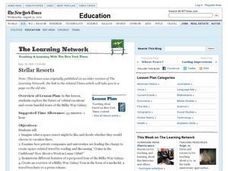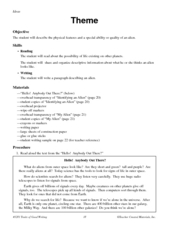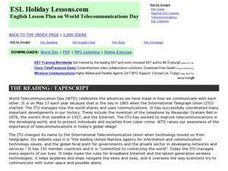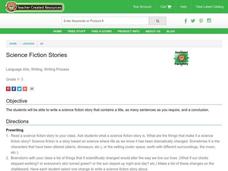K5 Learning
Space Based Astronomy
How much astronomy can you study with the naked eye? Learn more about the ways scientists explore the galaxy with a short reading passage and set of short-answer questions.
Kelly's Kindergarten
Kelly's Kindergarten: Names of Planets
Need some helpful images for your astronomy unit? Check out a slide show that hosts several pictures of planets with their names.
Curated OER
Stellar Resorts
Students explore the future of "orbital vacations" and create fanciful tours of the Milky Way Galaxy. Students respond to the following prompt in their journals "Entrepreneurs are currently designing concepts for accommodating tourists...
Curated OER
My Alien
Young scholars listen to text read from "Hello! Anybody Out There?" and then brainstorm what aliens from outer space look like and do they exist at all.
They then will describe the physical features and a special ability or quality of...
Curated OER
Science Fiction Stories
Learners write a story. In this genre lesson, students read a science fiction story and discuss its characteristics. Learners brainstorm a list of things that if scientifically changed would alter the way we live our lives. Students...
Curated OER
Inferring Character Traits
Here is a lesson which is "flexible," and can operate as an individual or whole class activity. After reading a book of their choosing, with the use of a semantic map, learners identify character traits. They infer how their feelings...
Curated OER
Lift Off with Rockets!
Students obtain information concerning rockets and the use of them in space, create their own rocket on the computer with the graphic choices on the website www.goobo.com, and write descriptive words or phrases to describe their rockets.
Curated OER
Our Amazing Skeleton
Students study the skeleton, about the number of and types of bones in the body, and how outer space affects astronauts' bones. They discover how to take care of their bones here on Earth to prevent osteoporosis, or, weakening of the...
Curated OER
Theme
Students examine a reading selection. In this descriptive writing lesson, students read an excerpt from "Hello! Anybody Out There?". Students discuss the idea of aliens living on other planets, describe what they think an alien looks...
Curated OER
Dolch Basic Sight Vocabulary in Alphabetical Order
In this language arts worksheet, students learn 220 commonly used words on this Dolch Word List. The words are arranged alphabetically.
Curated OER
Words in the News Hopes and Fears for Shuttle Discovery
Learners participate in vocabulary building activities including worksheets before reading an online article. They write a space travel diary of their first visit to outer space in a journal entry.
Curated OER
World Telecommunications Day
In this World Telecommunications Day learning exercise, students complete activities such as complete activities such as reading a passage, phrase matching, fill in the blanks, correct words, multiple choice, spelling sequencing,...
Curated OER
Science Fiction Stories
Students review the story writing process and the elements such as prewriting, drafting, editing, revising, publishing, and assessment. Next students write a science fiction story that contains a title, the requested number of...
Curated OER
Star Words
Students identify and categorize apostrophes. They create maps of the solar system and write simple sentences using apostrophes that describe each planet's characteristics.
Curated OER
B-movies and Plot: Story Elements, Writing, Media
Pupils use old "B-Movies" as a springboard to discuss and analyze traditional plot structures. They form groups and make their own 'movie' to demonstrate their knowledge.
Curated OER
Alien Visitor's Rewrite
Students role play the role of an alien who analyzes how the media represents the different social groups. In groups, they write their own story in which they add or revise a character to make it non-stereotypical. They share their...
Curated OER
The Weather Classroom: Atmosphere
Students explore the planets and their atmospheres online. They write the story of "Goldilocks and the Nine Planets" to explain how each planet's atmosphere differs from Earth's. They design a viable life form.
















